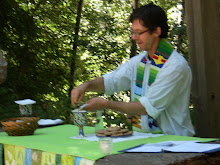In the past couple of days I’ve heard from two different members of my church about places they love that have been irrevocably changed by our warming climate. In the first instance I was sitting in the living room of a man whose principal home is in the foothills of the Sierra Nevada in Calaveras County. At one time he had been successful as a wildflower photographer. On the wall behind me was a brilliant close-up of a native Azalea, white and frilly, with serpentine streaks of lemon yellow. He told me how the market for his work dried up after 9-11 and has never come back. And then he said that the ecology of the Sierra foothills has changed so the flowers have also disappeared. Mild springs and lingering snowmelt have given way to a pattern of abrupt transition from cold, wet winter to the withering heat of central California summer.
The second conversation took place at the social hour after Sunday morning worship. A few of us were talking about our children and exercise and what kids can do today to get away from the computer and the flat screen and go outside. The topic of swimming came up, and our music leader started talking about the lake in Montana where her family has a cabin, and where she and her cousins swam as children. She mentioned that when they go there now their children need to limit their time in the lake and shower afterward to prevent “swimmer’s itch.” This is a condition caused by parasites in the water that didn’t used to be there before the lake’s temperature began to rise.
In neither of these conversations had we been talking about “global warming.” In fact, neither of the people I was talking used that term, or “climate change,” either. They were not angry or argumentative, and weren’t trying to convince me to take a political position—they were simply telling me in a matter-of-fact kind of way about their own experience of places in the American landscape and how rising temperatures had changed them for the worse. And this got me to wondering how many of us have stories like this about our country, stories that tell the truth about climate change.
This “truth” has been presented to the public as a scientific fact. It is attested to by experts, who can measure the effects of climate change, model future trends with sophisticated networks of computers, and tell us what concentration of CO2 in the atmosphere represents the threshold of irreversible and catastrophic global warming. The impersonal objectivity of these facts, and the consensus in the international scientific community around them, is supposed to be the strength of the argument for drastic changes in public policy and collective behavior.
But maybe this way of talking about the problem is actually a weakness. The climate change deniers in the oil industry and the US Chamber of Commerce have been very successful in exploiting the public’s resentment of experts and native skepticism about claims of absolute truth based on science. The merest handful of mercenary “experts” are all that’s required to create the perception that the “truth” of global warming is inconclusive, that there are two equally-legitimate sides to the issue, and that reasonable people can disagree.
Which is why we need a new kind of public speech about climate change. Instead of bludgeoning the people with facts produced by experts, it’s time to let them tell their own stories about the warming of America. Instead of abstract talk about the concentration of gases in the atmosphere, let’s hear common people talk about their favorite places, and what is happening to them. I’m imaging a national radio internet and television advertising campaign with each spot featuring a different story from someone like my friends from church--a backpacker, a park ranger, a farmer, a beekeeper, a lifeguard, a skier, and so on. Each will be a true story told by someone whose livelihood or leisure activity brings them into intimate contact with a part of the United States where rising average temperatures are degrading the quality of life for humans as well as the ecosystem. Each spot would end with the question “What’s your story?” and the campaign, called “American Warming” could have a companion website where people would be encouraged to upload video of their own stories of the impact of climate change on their lives.
The current strategy for mobilizing public opinion on this issue is losing effectiveness, so another one is called for, one that represents a fundamentally different approach. By making common people the experts, the American Warming campaign appeals to an aspect of the national character that has been skillfully used by the deniers—the determination to be one’s own authority on what really matters. It will encourage people to become attentive to the real impacts of climate change on their own families and communities, and to become articulate, common-sense voices about a problem no expert is required to explain.


No comments:
Post a Comment